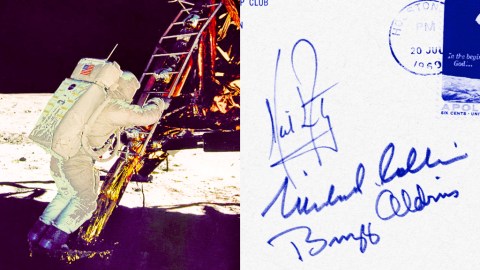Why Apollo 11 astronauts signed tons of autographs — then stowed them away

- In the early days of the U.S. space program, NASA didn’t offer astronauts life insurance for in-flight missions, and private life insurance was extremely expensive.
- To get around this, the crew of the Apollo 11 mission signed hundreds of autographs for their families to sell if they died.
- If the mission went wrong, NASA planned to cut communication with the astronauts and let them either suffocate or take their own lives.
It’s 4 p.m. on a Friday, and you’re clock-watching. Working at the desk of a life insurance company is rarely fun, but today feels like it’s dragged on forever. Then, in walks someone new.
“Hi, I’m Neil,” he says, “Neil Armstrong.”
“Hi Neil,” you say. “Before we get started, can I ask what it is you do?”
“Oh, sure, I’m an astronaut.” There’s a pause. You look up at Neil.
“As in, you work at NASA?”
“No, no, I’m an astronaut,” he says. “In a few months, I’m going to try and land on the Moon. It’s never been done before, and I think there’s a fifty-fifty chance of making it. I personally think we’ll probably get back to Earth, at least.”
He smiles. You don’t. This is going to need a phone call.
Life insurance signatures
Back in the 1960s, not many companies wanted to insure astronauts. With so few examples of space missions, actuaries couldn’t hope to capture the risks involved. Neil Armstrong thought he had a 90% chance of surviving, but neither he nor anyone else knew for sure. In the decade before Apollo 11, about half of all launched rockets blew up. When the Mercury Seven (the first Americans in space) tried to get life insurance in 1961, no one would take them up on it. As James Donovan puts it in his book Shoot for the Moon, “Even Lloyd’s of London, renowned for insuring almost anything, from Marlene Dietrich’s legs to a yo-yo champion’s fingers, would not cover these seven men.”
What were the crew of the Apollo 11 space mission to do? They had families to support, and they weren’t rich men. (Neil Armstrong earned a salary of $27,401 by 1969 — the top salary of the Apollo 11 astronauts, though probably not enough to secure his family’s financial future in the event of his death.) NASA did offer an insurance scheme, but in the early days of space exploration, it didn’t cover the actual space flight part. Some insurers offered to cover the crew, but it was hugely expensive, and what they offered in payout was far below the amount needed to support the astronauts’ families.
So, in the absence of sufficient life insurance, the Apollo 11 astronauts signed autographs known as “insurance covers.” As they entered their pre-launch quarantine, Neil Armstrong, Buzz Aldrin, and Michael Collins all signed hundreds of autographs. They gave them to a friend, who posted them to their families. Why? Because if they died on the mission, their families could sell the autographs as insurance.
As space historian Robert Pearlman put it, the crew knew “that there was a market for such things. There was demand. If they did not return from the Moon, their families could sell them — to not just fund their day-to-day lives but also fund their kids’ college education and other life needs.”
Left for dead
As it turns out, getting to the Moon was the least risky part of the mission. The more dangerous — not least because it was unknown — was getting off the Moon. Collins was orbiting the command module, and it was hugely difficult to dock. Then there was the possibility of a computer malfunction or a broken ascent engine. There was the fear that the astronaut’s spacesuits could just combust because of the lunar dust interacting with oxygen in the module.
Given the huge risks involved, a lot of different parties planned and scripted for the possible bad news. The truth, though, was that there was no Plan B. If things went sour, there was no way to fix it, and everyone involved knew it. As Christopher Klein put it, “Under the worst-case scenario, NASA planned to end communication with the [Apollo 11 crew], leaving them to either run out of oxygen or commit suicide with no further earthly contact.”
William Safire was a White House speech writer and had been asked to prepare something for President Richard Nixon, should the worst case play out. Although never needed, it remains a beautifully crafted and poignant speech, finishing with the lines, “For every human being who looks up at the Moon in the nights to come will know that there is some corner of another world that is forever mankind.”
The line is powerful, not least because it deliberately echoes one written by Rupert Brooke in World War One in a poem called “The Soldier.” Brooke was an English officer who died in Skyros, Greece, not long after writing it. But where Brooke wrote of England, Safire wrote of mankind. The 1969 Apollo 11 mission was a triumph of the human spirit. It was a collective cheer and celebration of mankind’s intelligence. But, as we’ve seen, it’s also a testament to the remarkable courage the astronauts took — when not a single life insurer would even touch the idea.





